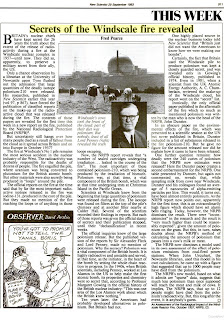CHARNEY HALL Nuclear Fallout
The name Windscale probably doesn’t mean much to the children of today but in the October of 1957 the newspapers were full of an incident which took place just around the Cumberland coast near the small village of Seascale.
We knew all about Seascale because we played football and cricket against its preparatory school. Fully exposed to the Irish Sea its location was forbidding, cold and wind swept, not at all like the more gentile, protected shores of Morecambe Bay.
Now reinvented as Sellafield, Windscale was Britain’s first nuclear power plant. It was originally built to produce the ominously named plutonium, a radioactive chemical element used in the hydrogen bomb, and a constituent of ‘Fat Man’ the atomic bomb which was dropped on Nagasaki, Japan and hastened the end of World War II.
Plutonium was a product of the Manhattan Project, a top secret American venture during World War II that worked exclusively to develop an atomic bomb. Los Alamos Laboratory tested the world’s first atomic bomb on 16 July 1945 and its director, Robert Oppenheimer was heard to say “We knew the world would not be the same. A few people laughed, a few people cried. Most people were silent.....’ Now I am become Death, the destroyer of worlds’....I suppose we all thought that, one way or another”.
It was this haunting suspicion of what was to come and BBC’s 1953 screening of The Quatermass Experiment, which my parents would not allow me to watch, that set the scene for the leak of radioactive materials from Windscale Pile No. 1 over a three day period in July 1957.
There was a general consensus that whatever had occurred at Windscale could happen again, and despite government’s assurances that nuclear reactors were safe there appeared to be a margin for error which however small could bring about a catastrophe of unimaginable proportions.
The decision was made not to evacuate people from the immediate area of the village but we heard that the local cows had ingested contaminated grass which in turn had affected the milk. For the next month all milk produced within 500km2 was diluted and poured away into the Irish Sea.
What happened to the radioactive cloud of particles which had escaped through the filter on top of Pile No. 1 (an afterthought nicknamed Cockcroft’s folley) was not admitted in detail. However years after the event it was eventually confirmed that whilst the longterm effect on the health of the local population was minimal, the radioactive cloud had spread across the UK and over parts of Europe.






Comments